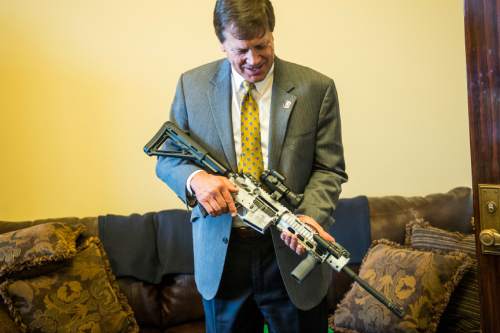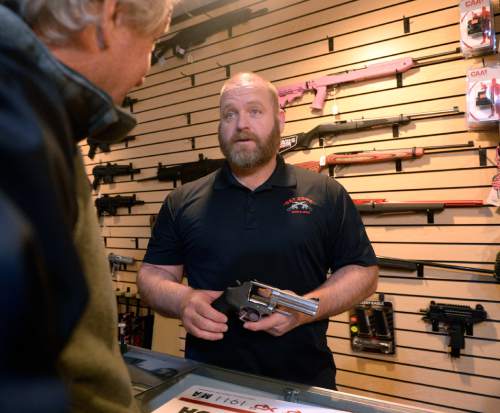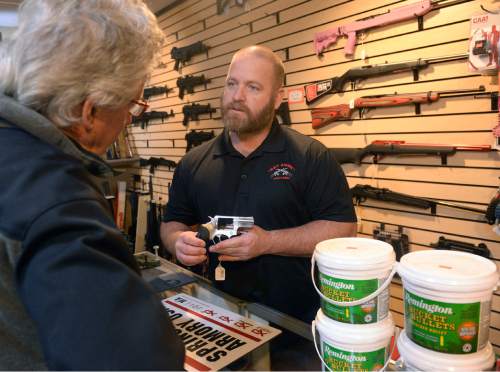This is an archived article that was published on sltrib.com in 2016, and information in the article may be outdated. It is provided only for personal research purposes and may not be reprinted.
Aurora, Newtown, San Bernardino and Orlando are forever linked, not only as sites of some of the deadliest mass shootings in U.S. history but by a highly controversial weapon possessed by each shooter.
There's debate about what, even, to call it. The gunman in Orlando fired a SIG Sauer MCX, not an AR-15 — the original semi-automatic assault-style rifle that frequently is misapplied as a generic term in the same way Q-Tip has come to mean cotton swab. Gun enthusiasts say both the MCX and the AR-15 are mischaracterized as assault rifles, which they associate with automatic fire. The preferred industry term, modern sporting rifle, irks gun control proponents who say the guns were designed without any thought toward sporting use.
But there's no debating that they are increasingly popular, and that Utah gun buyers are among many who have caught the bug.
More on Utah in a minute.
First, it bears noting the dearth of public information about how many of these weapons exist.
A 2015 report from the U.S. Bureau of Alcohol, Tobacco, Firearms and Explosives shows that total U.S. firearms manufacturing increased each year since the 2004 expiration of the Federal Assault Weapons Ban, which banned the sale of many AR-15-style rifles, from 3.1 million in 2004 to 10.8 million in 2013.
ATF doesn't track production of assault rifles, however. While U.S. manufacturers doubled their production of rifles from 2010 to 2013 alone (from 1.8 million to nearly 4 million), there's no telling what type of rifles they produced.
A National Rifle Association researcher tried to solve this problem by totaling the reported rifle production of manufacturers that almost exclusively produce AR-15-type rifles. He estimated in July 2009 that those manufacturers had produced 2 million since 1986. In 2013, production during the interim led him to double his estimate to 4 million.
But those estimates exclude production from manufacturers like Remington and Sturm, Ruger and Co., as well as foreign manufacturers. It's probably most fair to say that at least 4 million had been produced by 2013 and that there are likely many more today.
In Utah, neither state nor federal agencies record the make and model of firearms sold.
The best state-by-state data might be the National Shooting Sports Foundation's 2010 online survey of nearly 7,400 owners of AR-15-style weapons.
Included in the NSSF report is a map of responses by state, with a deeper shade of red in the states that had higher numbers of responses per household. People living in Montana and Wyoming were most likely to respond, with Utah seemingly among the top five or six states. An NSSF representative said by email that more specific state-by-state data is not available.
And that is about as precise as it gets.
It's not even possible to pin down Utah's total gun sales, given that the only tracked number — background checks — are a highly flawed indicator.
One check may be associated with multiple guns, buyers with concealed-carry permits are exempt from further checks and no background check is required when sales are made by private dealers and gun owners.
And besides, the state's Bureau of Criminal Identification only records whether the type of gun sought is a handgun or a long gun.
ATF keeps more specific data about weapons traced for law enforcement purposes. Of 1,110 firearms traced and recovered in Utah during 2014, 242 were rifles, but just 16 of those rifles were associated with the .223 caliber cartridge favored by most owners of semi-automatic assault rifles (76 percent of the NSSF survey respondents say they most recently used the firearm to fire a .223 caliber cartridge).
There is anecdotal evidence that despite their seeming infrequent use in Utah crimes, these guns are prized by Utah buyers.
"It's a very popular rifle here," said Jim Korth, a manager at Discount Guns & Ammo in Salt Lake. "It's versatile. People use it for hunting small game. It's a lot of fun to shoot."
Korth said Utah's gun-friendly laws — the state was named by Guns & Ammo magazine as the fourth-best for gun owners in 2015 — add to its popularity in the Beehive State, as do the models' value as a lightweight companion for ranchers who might encounter troublesome coyotes or prairie dogs.
But the rise of AR-15-style rifles is "not just a Utah thing," said Stuart Wallin, owner of Murray's Get Some Guns & Ammo. "They're popular everywhere."
Wallin said sales of AR-15-style guns surged after a December 2012 mass shooting at a Newtown, Conn., elementary school, when President Barack Obama called for restrictions on the weapons, and he expects another sales spike if presumptive Democratic nominee Hillary Clinton is elected.
For all the frustration of trying to peg sales of AR-15-style guns, federal stats on weapons once associated with Prohibition-era gang crimes are excellent, tracked in accordance with the 1934 National Firearms Act.
They reveal a strange fact about Utahns: They are more likely — to an unusual degree — to register suppressors, also known as silencers, which are attached to the barrel of a firearm to reduce the noise and muzzle flash.
As of February 2015, Utahns had registered more than 50,000 silencers, or more than 1 in 16 of the silencers registered in the United States. Only three much more populous states — Florida (50,000), Georgia (60,000) and Texas (131,000) — had more. Utahns were nearly seven times as likely as the average American to have a registered silencer, which are illegal in California, New York, New Jersey, Illinois, Massachusetts, Rhode Island, Hawaii and the District of Columbia.
Acquiring a silencer is an onerous task. A buyer must send a photo and fingerprints to the ATF to start an approval process that can take months, and the federal government collects a tax of $200.
Korth said silencers are "a novelty item more than anything else," associated with military snipers and James Bond. His "informed speculation" is that Utah's citizenry is especially patriotic, and its love for the Second Amendment bleeds into its love for guns — and, thus, tricking them out.
Utahns "know they can exercise their freedoms here and they do it just because they can," Korth said.
Other NFA revelations: Utahns are less likely than your average American to have registered explosives, about as likely as the average to have registered a short-barreled shotgun, slightly more likely to have registered a machine gun, and about twice as likely to have registered a short-barreled rifle.
Twitter: @matthew_piper —
Recent Tribune stories involving AR-15-style rifles
An AR-15 manufactured by Orem's Tegra Arms was the state Legislature's commemorative gun in 2015, covered in a gray beehive pattern with the state motto "Industry" emblazoned on its side.
Later that month, police fatally shot Springville 24-year-old Cody Evans when he brandished an airsoft replica of an AR-15.
In January 2013, a man carried an unloaded AR-15 to Riverdale's J.C. Penney Co. to make a statement about his Second Amendment rights.
That March, prominent Utah gun lobbyist Clark Aposhian made unwanted headlines when he left his AR-15 inside a locked vehicle outside his home and woke up to find it had been stolen — an experience shared by a Unified Police officer in August 2011.
In January 2011 — just one week after a gunman in Arizona killed six and severely wounded U.S. Rep. Gabrielle Giffords — a man carried an assault rifle to Orem's University Mall, earning a year's probation after he explained that he meant to demonstrate Utah's open carry laws to a friend and mall security.
In August 2010, a man from Fredonia, Ariz., used an AR-15 to kill Kane County Sheriff's Deputy Brian Harris.
The same month, Army vet Brandon Barrett was armed with an AR-15 when he shot a police officer outside the Grand America Hotel. Police returned fire and killed Barrett. —
Semi-automatic assault rifles
A 2010 online survey of nearly 7,400 semi-automatic assault rifle owners from the National Shooting Sports Foundation found that:
• The average price for respondents' assault rifles was $1,083, with an average of $436 spent on accessories for the famously customizable rifles.
• Younger owners were more likely to have bought semi-automatic assault rifles with red dot sights instead of a scope, as well as higher-capacity magazines.
• Of respondents, 99 percent were men, 60 percent owned more than one semi-automatic assault rifle and 44 percent had a military or law enforcement background.
• Respondents rated the rifles' use, in terms of importance: 1. Recreational target shooting, 2. Home defense, 3. Collecting, 4. Varmint hunting, 5. Competition shooting, 6. Big-game hunting.







